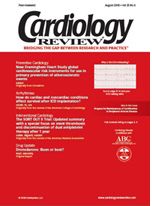Preventing restenosis in diabetic patients with drug-eluting stents
Diabetic patients have been the major population subset in which high restenosis and event rates have made percutaneous coronary interventions controversial as the preferred revascularization strategy, particularly in those with multivessel disease. Despite the recent ubiquitous use of bare metal stents, diabetic patients clearly have derived less benefit because of more aggressive fibrointimal hyperplasia, resulting in higher angiographic restenosis and revascularization rates. However, the recent arrival of drug-eluting stents (Cypher sirolimus-eluting stent and Taxus paclitaxel-eluting stent) promises to even the playing field between diabetic and nondiabetic patients.
Drs. Addo and Moussa (page 18) report on the SIRolImUS (SIRIUS)-coated Bx Velocity balloon-expandable stent in the treatment of patients with de novo coronary artery lesions trial substudy demonstrating the benefits of the sirolimus-eluting stent in diabetic patients compared with a bare metal stent. The sirolimus-eluting stent reduced target lesion revascularization from 22.3% to 6.9% (P < .001) and major adverse cardiac events from 25% to 9.2% (P < .001). In comparison, nondiabetic patients had a reduction in target lesion revascularization from 14.1% to 2.99% (P < .001) and in major adverse cardiac events from 16.5% to 6.5% (P < .001).
The 9-month Diabetes and Sirolimus-Eluting Stent trial,1 which compared sirolimus-eluting stents with bare metal stents in diabetic patients, recently reported similar results. There was an 88% reduction in late lumen loss (P < .001) and a 76% reduction of in-segment restenosis (P < .001) at 9 months with the sirolimus-eluting stent. The rate of major adverse cardiac events was 11.3% with a sirolimus-eluting stent versus 36.3% with a bare metal stent, largely driven by a target lesion restenosis of 31.3% with the bare metal stent versus 7.5% with the sirolimus-eluting stent. There were no differences in cardiac death or myocardial infarction (MI) rates between the groups.
The meta-analysis2 of TAXUS II, IV, and VI included 458 diabetic patients (154 insulin-dependent). Treatment with the paclitaxel-eluting stent reduced target lesion revascularization at 1 year by 68% in nondiabetic patients (14.2% to 4.6%; P < .001), 71% in non—insulin-dependent diabetics (21.4% to 6.2%; P = .001), and 71% in insulin-dependent diabetic patients (19.3% to 5.6%; P = .015). Both sirolimus and paclitaxel block the phosphatidlyinositol-3-kinase pathway mechanism by which insulin promotes restenosis, which is amplified in insulin resistance. Paclitaxel also blocks the mitogen-activated protein kinase (MAPK) pathway, which promotes restenosis in insulin-dependent diabetic patients. In the recently reported REALITY trial, a comparison of the sirolimus-eluting and paclitaxel-eluting stents demonstrated greater fibrointimal hyperplasia inhibition and less frequent stent thrombosis overall with the sirolimus-eluting stent, although no significant difference was noted in in-lesion restenosis when comparing stents in the diabetic subgroup.3
Drug-eluting stents have not eliminated the need for adjunctive therapy in the diabetic patient. In particular, suboptimal glycemic control (usually defined as a hemoglobin A1C level above 7.0%), as demonstrated in TAXUS,2 is associated with an increase in restenosis risk after treatment with a drug-eluting stent (3.8% versus 0%). Despite improvements in target vessel revascularization rates with drug-eluting stents, diabetic patients remain at increased risk of MI and death. Periprocedural platelet glycoprotein IIb/IIIa inhibitor therapy has improved survival at 6 months in diabetic patients treated with bare metal stents.4 Pending reports of their efficacy in patients treated with drug-eluting stents, it is reasonable to continue to base their use on periprocedural risk assessment. Diabetes is a prothrombotic state. Diabetic patients, in particular, should be considered for prolonged antiplatelet therapy because of reports showing delayed subacute thrombosis due to delayed reendothelialization in patients treated with drug-eluting stents, as well as demonstrated treatment efficacy.5,6
The drug-eluting stent trials7 have also demonstrated that nontarget lesion events are particularly significant in affecting long-term prognosis. One-year outcomes after sirolimus-eluting stent treatment demonstrated no difference in target vessel revascularization in nondiabetic patients versus non—insulin-dependent diabetic patients and insulin-dependent diabetic patients (1% versus 2% versus 2.9%), but there was a difference in death (1.5% versus 4% versus 8.8%; P = .08) and acute MI (0% versus 2% versus 5.9%; P = .002). It is important to remember that the stented lesion is a marker, particularly in the diabetic patient, for much more extensive coronary disease. Secondary risk factor modification is, therefore, essential if the long-term mortality rate after stenting is to equal or better that of surgical revascularization.
